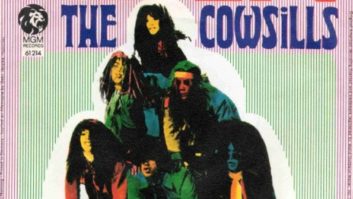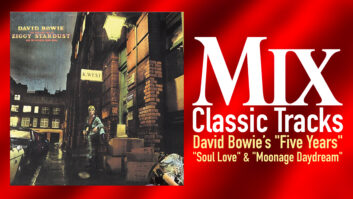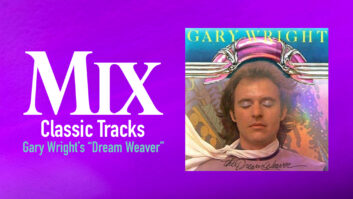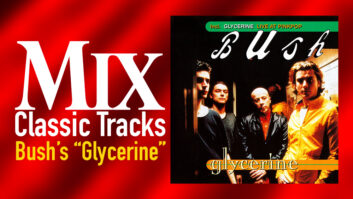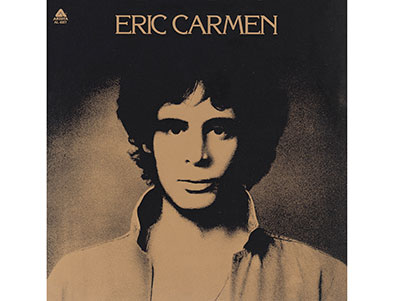
In late 1974, Raspberries were still in full gear as one of power pop’s biggest bands. But the Cleveland-based group’s front man, Eric Carmen, was already composing what would be the first megahit of his solo career, which began perhaps sooner than expected with the group’s demise the following year.
Trained as a classical pianist at the Cleveland Institute of Music, Carmen was pulled astray at 14 when he first heard The Beatles. “I said, ‘Wait a minute, they don’t have any pianos. I better learn something else, cause this is what I want to do,’” he recalls. But his classical chops would remain and would serve as the root of his first two solo hits, “All By Myself” and “Never Gonna Fall In Love Again,” both recorded on his first post-Raspberries excursion, Eric Carmen, released in November 1975 on Arista Records.
“All By Myself,” like all of the songs on the album (and much of Carmen’s Raspberries’ output), was written on the Model O Steinway piano in the living room of his 19th floor apartment in The Watergate, a high-rise overlooking Lake Erie in the Cleveland suburb of Euclid. As part of his writing routine, Carmen would get inspired by listening to his favorite piece of music—Rachmaninoff’s “2nd Piano Concerto.” He recalls: “About 10:30 or 11 every night, I’d turn everything off and go sit in my living room, where there was nothing but two chairs, a big stereo system and my piano.”
Properly inspired, he began composing the first bits of what would become a 4.5-minute classical interlude within “All By Myself,” written over several months, adding bits and pieces at each sitting. “Eventually, I thought to myself, ‘This is really cool. Now I need a song to put it into the middle of,’” he says.
A favorite theme in the 2nd adagio movement of the Rachmaninoff concerto got his attention. He remembers thinking, “‘If I can change the timing of this a little bit, I could adapt that theme, and it could be the verse of a pop song.’ That became the opening line of ‘All By Myself.’”
The lyrics came months later, beginning with the title, which he wrote in just 45 minutes. He played the 7.5-minute composition—verses and choruses, plus the classical interlude—for bandmate Scott McCarl at one of Raspberries’ last gigs in April 1975, singing it in a Barry Gibb-style vocal he had originally considered.
That same year, Carmen went looking for a post-Raspberries label and approached Clive Davis, who had created Arista Records the year before out of the ashes of Bell Records and several other labels. Unlike other execs, who insisted the artist submit a cassette demo, Davis, on Carmen’s invitation, flew to Cleveland, where the artist played him most of the album on his piano. “I remember him sitting on the bench next to me, singing the chorus to ‘All By Myself,’” Carmen relates. “The next day, Clive flew back to New York and offered me a deal. For a guy who couldn’t get into his office a few years earlier, to have him fly out and then sign me…that was pretty cool.”
To produce, Carmen stayed with legendary rock producer Jimmy Ienner, who had also helmed the four Raspberries albums. Like Davis, Ienner flew to Euclid that spring to hear the songs, which would be recorded in August and September. “I like to sit down with an artist, they give me what they’re doing and feeling or what they want to do, and we talk about it,” the producer explains. When it came to “All By Myself,” he noted, “This is a song for every kid who’s feeling insecure or lonely. That was the audience for that track. I thought [the classical interlude] was perfect for the piece. And it left room for beautiful, unique orchestration to accompany the rest of the song.”
While the Raspberries albums were recorded at Record Plant New York with engineer Shelly Yakus, for Carmen’s new disc, Ienner turned to ODO Sound Studios in Manhattan. Owner Vinnie Oddo had built the studio in 1961-62 into a former nightclub, in the basement at 254 West 54th Street, next door to what would become Studio 54.
ODO had a single live room—an ample 40 by 40 feet. The floor was carpeted, save for a 10-by-10-foot parquet area in front of the control room window, allowing some amount of reflection for spot players. Burlap bags filled with Fiberglas insulation hung on the walls.
When staff engineer Jack Sherdel arrived on the scene, the control room featured a tube broadcast console with four outputs and no track selectors. “All of the bubblegum stuff was done on that console,” he remembers. “That was all 4-track. And we had four Pultec equalizers in a box sitting off to the side. There was no EQ on any channels. Nothing.” The desk was eventually updated to a Dynamix console, and, just prior to the Carmen recordings, ODO underwent a control room upgrade, including a custom Quad-8 desk, made by Studio Consultants.
The tape machines originally consisted of a pair of mono Ampex recorders, accompanied by a 2-track. These were updated over the years to Scully 2-, 4- and 8-track machines, and, with the final upgrade, an MCI 16-track, on which Carmen’s album was recorded, running at 30 ips, with no Dolby. For reverb, ODO had an EMT plate and an Eventide reverb, supplemented, at times, by the studio’s rest room.
As part of the fresh start, Carmen hired a new band, a local group called Magic that he had seen on Christmas night at a popular Cleveland venue, the Agora Club. The group—Rich Reising (guitar/keyboards), Donny Krueger (drums), Dan Hrdlicka (guitar), George Sipl (keyboards) and Steve Knill (bass)—was joined by Raspberries drummer Michael McBride and converged at Carmen’s apartment to rehearse for three months, from May to June.
“We were in a new studio, with a new engineer, and I wanted to get a feel for what was going on there before we got to ‘All By Myself,’” Carmen says. “I knew that it was going to be a very, very difficult track to cut because it was just piano, bass and drums, no vocal, and it was seven-and-a-half minutes long.”
There were also two drummers. While the two played in unison for most of the songs, for this one Carmen assigned tasks to each. “Mike McBride was a great timekeeper, but didn’t naturally play with the sensitivity of a drummer who plays tom fills that are kind of behind the beat,” he explains. “So I decided the way for me to approach it was to have Mike play kick drum, snare and hi-hat, and have Donny Krueger just play snare and tom fills. And they were pretty tight. Every so often, you can hear just a little flam when they both hit the snare together. But it actually makes it sound really thick.”
While the two drummers played identical kits, and Sherdel miked them in the same manner, he varied the mics between the players, “so they wouldn’t sound exactly the same, and would help thicken them up,” he explains. One’s snare received an AKG 414, while another was miked with one of the two American Microphone D4T “Salt Shaker” microphones that were a favorite of the studio. Kicks took a Sennheiser 421 and an EV 88, with toms covered by 421s on one, and a Beyer ribbon mic on the other.
With only a single 16-track machine, Sherdel first, with the band playing live, tracked the two drummers to 8 or 10 tracks, and then bounced them down to 4, to create room for overdubs. During mixing, Ienner had him apply plenty of EQ, echo and delay, particularly on the lead-ins to the choruses. “I wanted it to sound like a building fell down,” the producer states.
The group tracked the song live, with Carmen playing a Baldwin piano that had “the hardest action I have ever played in my entire life,” he recalls. Sherdel close-miked it with a pair of Telefunkens. “We wanted to do it live, and weren’t going to overdub it, except Eric’s vocal,” he states. “But part of the unique sound we got was just through the leakage into those piano mics, which picked up some room ambience, which was kind of nice.”
Carmen led the group through 25 takes of the song—the group playing the rhythm section, Carmen playing his classical break, and then the band returning to close the song. “Somebody was always a little bit behind or ahead of it,” Ienner notes of the many takes. “I knew this melody was so precise, and had to hit it, knowing where the vocal needed to sit.” Finally hitting their mark on Take 25, the group went into the control room for a listen, only to find that a limiter had failed them. “The next take, Take 26,” says Carmen, “is the one you hear.”
Ienner’s normal methodology, Sherdel notes, was to add a reference vocal, either after completing a rhythm track or after several songs had been recorded. But no such vocal had been recorded when Carmen brought in guitarist Hugh McCracken, the only session musician (other than string players) on the album, for the song’s Harrison-esque lead guitar break. Carmen played back the rhythm track for the guitarist in the control room.
“When it came to the part where the solo was going to be, we walked out to the studio to the piano, and he said, ‘What kind of thing are you thinking about?’ And I put my hands on the keyboard and started to sing, right off the top of my head.’ He loved it, and played it.”
McCracken took three passes at the solo, played with a slide on his Stratocaster while sitting in the control room, direct to the console. Sherdel produced a single-track comp, which during mixing was treated with a delay unit made by one of the staff engineers, Dale Ashby, resulting in a beautiful stereo, drawn-out sound when combined with the raw guitar track. “When he played it, it was happy sounding,” says Ienner. “I wanted it to sound a little sadder, to make it fit emotionally with the track.”
For the string overdubs, Ienner brought in veteran arranger Charlie Calello, whose credits included Frank Sinatra and The Four Seasons, to work closely with Carmen.
To brighten up the mostly carpeted studio, Sherdel sent out for a heap of plywood sheeting, which was laid on the floor and duct taped together. “New York studios, especially ODO, had notoriously low ceilings,” he explains. “That room was really dead, so the plywood helped liven it up. The hardest part, though, was keeping it quiet. We had 40 musicians in there—the room was full—all tapping their feet to keep time. We had to ask them to take their shoes off.”
The orchestra did one pass, recorded to four tracks, which Sherdel mixed down to two. As was common then, they asked for another pass to double the sound, even though, contractually, they would normally have had to pay double. “It was kind of an unwritten rule back then,” Sherdel chuckles. “You didn’t say anything, just, ‘Can you do it again? I think we need another one.’” The strings were mixed live to stereo, with the stereo pattern reversed for the second set, creating a lush, full string sound.
With the track complete, the last step was Carmen’s lead vocal, which Sherdel recalls recording with a Neumann U 47, slightly compressed. Ienner, keen to capture the emotion of the lyric, had everyone leave the control room, save Sherdel, who was asked to sit on the floor so that Carmen couldn’t see him. “The very beginning of that vocal, that first line, was so emotional,” the producer recalls. “I made everybody leave, turned all the lights off, and I made Eric think about everybody in school who had either made him lonely or who had made him feel less than himself. I knew the song had to introduce itself. He had tears in his eyes.”
After 20 or 25 takes (“Eric is a perfectionist,” says Sherdel), the engineer applied a favorite effect. “I liked to delay the send to the EMT plate reverb, like a slapback delay, and then combine that with the dry vocal. It made it different; it brought the vocal close to you, but it had reverb applied to it.”
The completed track, selected by the label as the first single from the album Eric Carmen, was still 7.5 minutes long. “Clive said, ‘Whoa, we can’t put out a seven-and-a-half minute single. You’ve gotta come up with an edit,’” Carmen recalls. “The problem was that the piano interlude changes keys four times. There was no logical way to cut it.”
He, Ienner and Sherdel spent a long day and night attempting a handful of edits, eventually throwing their hands up and doing what Carmen called the 4:22 “joke edit,” which was eventually released. With just a bit of the full classical interlude heard on the LP version, Ienner notes, “It gave you the story, it didn’t give you the dialog.”
The single, released on December 1, 1975, reached No. 1 on the Cash Box charts (No. 2 on Billboard), selling more than a million copies and certified gold the following April.
Though Carmen, when writing the song, had thought the Rachmaninoff concerto was in the public domain, the song’s success brought its presence to the attention of the composer’s family, who pointed out that that was not the case. Carmen then arranged to pay the estate a 15 percent royalty, but still considers the song a gift. “I always felt that Rachmaninoff gave me those verses, for loving that piece so much.”
Special thanks: Ken Sharp, Bernie Hogya
